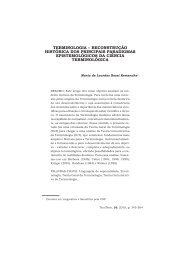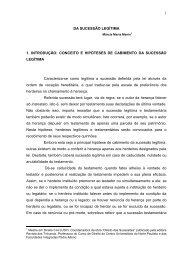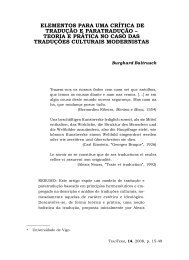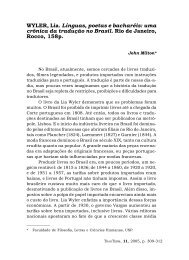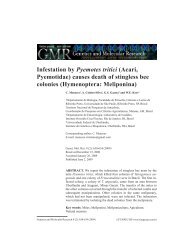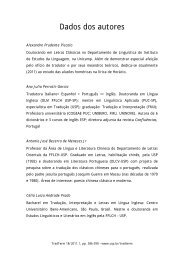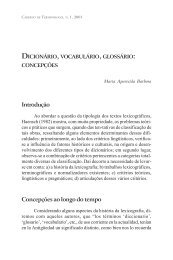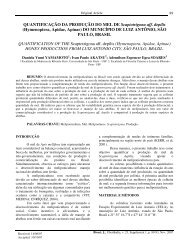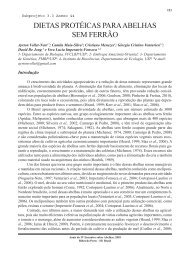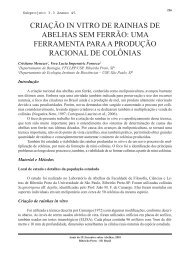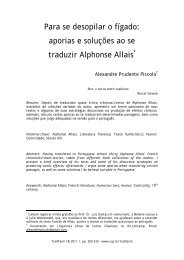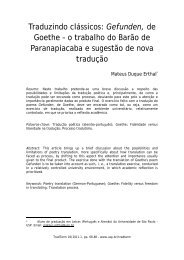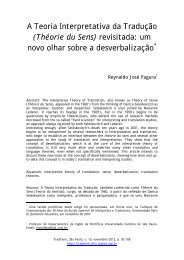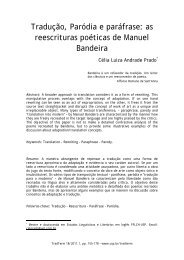Bees as pollinators in Brazil - USP
Bees as pollinators in Brazil - USP
Bees as pollinators in Brazil - USP
Create successful ePaper yourself
Turn your PDF publications into a flip-book with our unique Google optimized e-Paper software.
to this genus a high importance for additional<br />
<strong>in</strong>vestigation.<br />
6. At le<strong>as</strong>t 9 species of st<strong>in</strong>gless bees from<br />
Amazon (Melipona spp., Aparatrigona spp.,<br />
Plebeia spp. and Scaptotrigona spp.) could<br />
be kept m<strong>as</strong>sively to be used on poll<strong>in</strong>ation<br />
programs. Tropical crops <strong>as</strong> cupu<strong>as</strong>su (Theo -<br />
broma grandiflorum), urucum (Bixa orellana),<br />
<strong>as</strong>sai (Euterpe oleracea), hogplum<br />
(Spondi<strong>as</strong> mombim), guaraná (Paull<strong>in</strong>ia<br />
cupana) are some examples of Amazon<br />
plants witch demands poll<strong>in</strong>ation services<br />
from st<strong>in</strong>gless bees.<br />
Improv<strong>in</strong>g knowledge b<strong>as</strong>e<br />
1. Improve regional st<strong>in</strong>gless bees collections<br />
and the use of molecular techniques needed<br />
to help identification.<br />
2. Automatic monitor<strong>in</strong>g of flight activity for<br />
model<strong>in</strong>g <strong>in</strong> climate change issues.<br />
3. Promote st<strong>in</strong>gless bees’ conservation <strong>in</strong><br />
are<strong>as</strong> where logg<strong>in</strong>g is allowed.<br />
4. Study nest sites; nests populations; nests<br />
sizes and densities.<br />
5. Improve nests availability through the<br />
establishment of ecological corridors.<br />
6. Establish techniques for ecological restoration<br />
and <strong>poll<strong>in</strong>ators</strong>.<br />
7. Identify <strong>poll<strong>in</strong>ators</strong> <strong>as</strong>semblages <strong>in</strong> ecotones<br />
and fragments.<br />
8. Promote st<strong>in</strong>gless bees conservation <strong>in</strong><br />
agricultural landscapes, also promot<strong>in</strong>g<br />
heterogeneity <strong>in</strong> landscapes.<br />
9. Study exotic and native <strong>poll<strong>in</strong>ators</strong>’ ecological<br />
relationships.<br />
10.Study species acceptation <strong>in</strong> trap nests of<br />
different materials.<br />
11. Use molecular tools to evaluate: density of<br />
colonies; males provenience; populationcharacteristics;<br />
relatedness among nests;<br />
number of nearby nests (through the analysis<br />
of male clouds near the nest entrance, or<br />
by analyz<strong>in</strong>g workers collected <strong>in</strong> a transect).<br />
Workshop I 83<br />
12.Develop metanalysis, data analysis and<br />
scientific publication diffusion of <strong>poll<strong>in</strong>ators</strong><br />
issues.<br />
14.Improve techniques for nests development<br />
<strong>in</strong> hives.<br />
15.Evaluate queen survivorship <strong>in</strong> the colony.<br />
16.Compare the characteristics of <strong>in</strong>itial and<br />
mature nests.<br />
17.Study sex-ratio and queen production <strong>in</strong><br />
selected species.<br />
18.Improve honey production, quality and<br />
conservation.<br />
19.Evaluate pollen availability and quality.<br />
20.Study foragers’ lifetable <strong>in</strong> different se<strong>as</strong>ons.<br />
21.Study se<strong>as</strong>onal <strong>as</strong>pects of life cycle, ma<strong>in</strong>ly<br />
<strong>in</strong> subtropical environment.<br />
F<strong>in</strong>al remarks<br />
Concern<strong>in</strong>g st<strong>in</strong>gless bees’ biology, there is an<br />
urgent need for implement the research<br />
groups <strong>in</strong> the different <strong>Brazil</strong>ian regions for<br />
improv<strong>in</strong>g the local knowledge b<strong>as</strong>is. Regional<br />
groups should be tra<strong>in</strong>ed <strong>in</strong> standard methodologies<br />
to apply <strong>in</strong> their region.<br />
Improve capacity build<strong>in</strong>g and tra<strong>in</strong><strong>in</strong>g <strong>in</strong><br />
all levels, <strong>as</strong> well <strong>as</strong> concentrate studies <strong>in</strong><br />
nests requirements <strong>in</strong> order to implement the<br />
new law 02000.006608.2000-81 concern<strong>in</strong>g<br />
to st<strong>in</strong>gless bees beekeep<strong>in</strong>g.<br />
Conservation of st<strong>in</strong>gless bees <strong>in</strong> logg<strong>in</strong>g<br />
are<strong>as</strong> is an important issue, due to the large<br />
<strong>Brazil</strong>ian area that will be used for logg<strong>in</strong>g <strong>in</strong><br />
Amazon region.<br />
Develop life history studies for a selected<br />
number of st<strong>in</strong>gless bees species that are<br />
potential generalist <strong>poll<strong>in</strong>ators</strong>.<br />
Provide literature <strong>in</strong> Portuguese and available<br />
on l<strong>in</strong>e.



